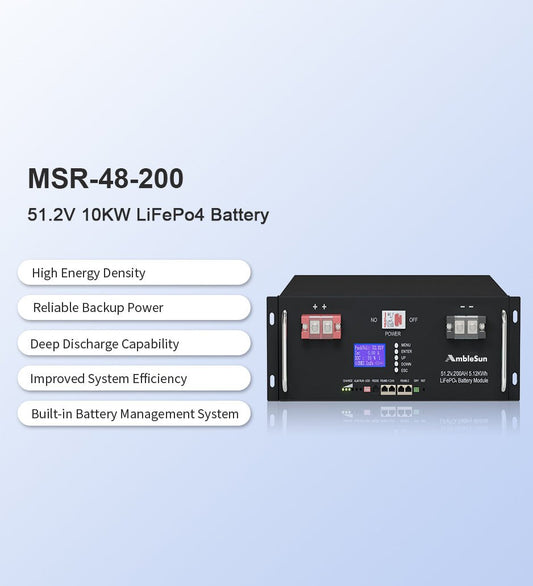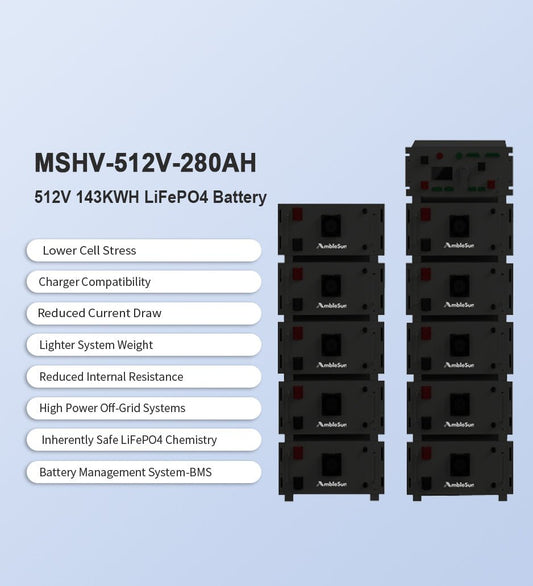Your Cart
How to Parallel Lifepo4 Lithium Batteries

How to Parallel Lifepo4 Lithium Batteries
LiFePO4 batteries, renowned for their long lifespan, stability, and safety, have garnered significant attention in both the renewable energy sector and everyday applications.
But like all power sources, understanding how they’re charged, particularly in configurations like parallel and series, is pivotal to maximize their efficiency and longevity.
This article delves into the nuances of charging LiFePO4 batteries in parallel and series arrangements, highlighting the best practices, benefits, and considerations one must consider for optimal performance.
What Are The Two Types Of Battery Connections?
When diving into LiFePO4 battery charging, understanding the different types of battery connections is foundational. These connections determine how individual cells or packs share electrical current, impacting overall voltage, capacity, and charging dynamics. There are two primary connection configurations:

- Series Connection:In a series setup, cells are linked end-to-end, with the positive terminal of one connected to the negative terminal of the next. This elevates the total voltage to the sum of all the individual cells while the capacity remains consistent with a single cell. For LiFePO4 batteries, often with a nominal voltage of 3.2V, series connections are crucial for applications requiring higher voltage.
- Parallel Connection: In parallel configurations, cells are connected side by side, with all positive terminals and all negative terminals linked together. This approach augments the battery’s total capacity, summing up the capacities of all connected cells, while the voltage mirrors that of one cell. When more energy storage or prolonged discharge times are needed without an increase in voltage, parallel connections shine.
For advanced applications, like powering electric vehicles or extensive renewable energy systems, LiFePO4 batteries can be arranged in a combination of series and parallel, known as “series-parallel” configurations. This setup tailors the battery pack to meet specific voltage and capacity demands, ensuring optimal performance and longevity.
Why LiFePO4 Cells Need To Be Connected In Parallel And Series?
Like other types of battery cells, LiFePO4 (Lithium Iron Phosphate) cells are often connected in parallel and series configurations to meet specific voltage and capacity requirements for various applications. The following is some information about series and parallel connections before we get into the details further.
When Do You Need To Connect Batteries In Series?
When LiFePO4 cells are connected in series, the voltage of each cell is added up.
For instance, if you have four 3.2V LiFePO4 cells in series, the combined voltage becomes 12.8V. This is essential for applications that require higher operating voltages.
When Do You Need To Connect Batteries In Parallel?
When Charging lifepo4 batteries in parallel voltage remains the same, while the capacity (or Ampere-hour, Ah) of the cells adds up while the voltage .
For example, if you have two 100Ah LiFePO4 cells connected in parallel, the combined capacity becomes 200Ah, but the lifepo4 charging voltage stays the same as one individual cell. This is useful for applications demanding higher energy storage or extended runtime without an increase in voltage.
Combining Series And Parallel Connections
Combining series and parallel connections allows for customization of the battery pack’s energy (Wh) and power (W) density to suit specific needs, such as in electric vehicles or stationary energy storage systems.
Charging Lifepo4 Batteries In Series
Charging lifepo4 batteries in series is common, especially when a higher voltage is required for a particular application.
Charge the two batteries separately and check that they are within 0.5V or 50 millivolts with a voltmeter before connecting them in series.

Remember not to mix batteries of different voltages. Using batteries with varied voltages can lead to uneven charging and discharging rates, which in turn can cause strain and imbalances among the cells.
If the battery gets out of balance, disconnect the batteries, charge them individually and reconnect them again. When charging in a series connection, multi-bank is the preferred choice.
Charging Lifepo4 Batteries In Parallel
Charging lifepo4 batteries in parallel involves linking them to enhance their overall capacity without altering their voltage, allowing for prolonged usage at consistent power levels.

When connecting the batteries in parallel, you should ensure the battery is within 100 millivolts (100mV or 0.1V); if not, there is an increased chance of battery balancing. So, before connecting the batteries, completely charge them individually and check with the voltmeter.
The charges to charge the battery must be of slightly higher voltage. Low voltage chargers will not affect the battery adversely but cannot provide full rated capacity. While BMS may disconnect the battery when having higher voltages than the above-given requirements.
Can You Connect 4 Lifepo4 Batteries In Parallel?
Yes, you can connect 4 LiFePO4 batteries in parallel, its generally safe!
By connecting 4 batteries in parallel, you will get the same voltage as a signal battery with an increased capacity that will last four times longer in terms of energy storage or discharge time.

For a successful parallel setup, it’s crucial that all four batteries possess the same voltage, capacity, state of charge, and ideally hail from the same manufacturing batch. This uniformity ensures an even distribution of charging and discharging duties across the batteries.
Can I Charge A LiFePO4 Battery With A Normal Charger?
The direct answer to your question is, YES!
A normal battery charger of would be enough to charge a lithium battery. Moreover, sometimes an AGM charger would also work fine for lithium batteries.
But here it is to be noted that battery chargers must be of slightly higher voltage. Following are some of the charging parameters you must remember:
|
Battery Voltage |
Charging Parameters |
|
12V |
14V-14.2V |
|
24V |
28V-28.4V |
|
36V |
42V-42.6V |
|
48V |
56V-56.8V |
There are other methods like, charging LiFePO4 batteries with a generator or solar panel will also work fine. But when charging LiFePO4 batteries with solar panels or generator you will typically need a suitable charger or a charge controller specifically designed for LiFePO4 batteries.
Is It Better To Connect Lithium Batteries In Series Or Parallel?
Whether it’s better to connect lithium batteries in series or parallel depends on the desired application and objectives. Both configurations have their advantages and disadvantages:
Series Connection:
Advantages:
- Increased Voltage: The total voltage is the sum of the voltage of each cell.
- Common for Many Applications:Many devices require higher voltages to operate, so batteries are often connected in series to achieve this.
Disadvantages:
- Same Current Flow: All cells must carry the same current, which can lead to problems if one cell is weaker or more discharged than the others. A weaker cell can get over-discharged, leading to capacity loss or even failure.
- Balancing Required:Over time, cells in a series can become unbalanced (they don’t have the same state of charge). To prevent this, a battery management system (BMS) with balancing functionality is typically needed.
Parallel Connection:
Advantages:
- Increased Capacity:The total capacity (measured in Ampere-hours or Ah) is the sum of the capacities of each cell. For example, if you connect three 2000mAh cells in parallel, you get a total capacity of 6000mAh.
- Tolerance to Weak Cells:Since all cells share the same voltage level, a weaker cell will simply deliver less current. However, the stronger cells will compensate for it.
- Voltage Remains the Same:The total voltage of the battery remains the same as that of an individual cell.
Disadvantages:
- Current Sharing Issues:Wiring lithium batteries in parallel danger in a way that if cells are not perfectly matched, they might not share current equally. This can cause some cells to be underutilized, while others may be overburdened.
- Increased Short Circuit Current:The combined high capacity can lead to a very high short circuit current, which can be dangerous and requires safety precautions.
Some Considerations:
- When using both series and parallel (like in many battery packs), it’s generally best to first connect cells in parallel to make modules, and then connect those modules in series. This can help in achieving both desired voltage and capacity while maintaining a balance among the cells.
- Always use a BMS when creating custom battery packs to ensure safety and longevity of the pack.
- Ensure that the cells you are connecting together, whether in series or parallel, are of the same type, capacity, and state of charge. This minimizes risks and ensures optimal performance.
FAQ For Charging Lifepo4 Batteries
Can I Connect 12v Lithium In Series?
Yes, you can connect 12V lithium batteries in series. When you do, the voltages of each battery will add up. For instance, if you connect two 12V lithium batteries in series, you will get a total voltage of 24V.
Can I Connect 12v Lithium In Parallel?
Yes, you can connect 12V lithium batteries in parallel. When connected in parallel, the voltage remains the same (12V in this case), but the capacity (Ah) adds up. It’s essential to make sure the batteries you’re connecting have the same voltage level and ideally the same state of charge to prevent unwanted current flows between the batteries.
Are Lifepo4 Batteries Safe?
LiFePO4 (Lithium Iron Phosphate) batteries are among the safest lithium-ion chemistries available. They are less prone to thermal runaway compared to other lithium-ion chemistries, such as LiCoO2 (Lithium Cobalt Oxide). Some reasons for their safety include:
- It has a stable crystal structure, which reduces the risk of fire or explosion.
- It can tolerate higher temperatures
- LiFePO4 doesn’t contain harmful heavy metals compared to other batteries chemistries.
No comments
















0 comments